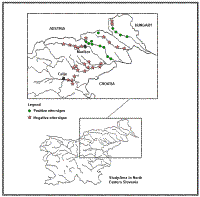 |
Last Update:
Thursday November 22, 2018
|
| [Home] |
|
Volume 10 Pages 1 - 56 (October 1994) Citation: Gutleb, A.C. (1994) Heavy Metals, OCPs and PCBs in Spraints of the Otter from Slovenia. IUCN Otter Spec. Group Bull. 10: 31 - 34 Heavy Metals, OCPs and PCBs in Spraints of the Otter from Slovenia Arno C. Gutleb Department of Toxicology, Landbouwuniversiteit Wageningen, Tuinlaan 5, NL-6703 HD Wageningen, The Netherlands
The otter (Lutra lutra) has declined in most parts of its former range in Europe. Much attention is paid to the contamination of otters and their habitats but little information is given on that problem in former east European countries. Furthermore little information is available on the distribution of the otter in these countries. Hönigsfeld (1984) gives an overview on the occurrence of the otter in Slovenia. No data are available on the contamination of otters from Slovenia. STUDY AREA AND METHODS Only the parts of Slovenia adjacent to the areas in Austria with positive otter signs were surveyed. The samples were collected in 1992 and 1993 as part of a study on the contamination of various contaminants in Austria and some neighbouring countries (Gutleb, in prep). A total of 39 sites was surveyed for otter signs following the method of Macdonald (1983). All samples were kept deep frozen prior to analysis. Heavy metals were detected in single spraints by using AAS. For the analysis of organochloropesticides and PCBs up to ten spraints from the same place were put together and contaminants were determined with a GC-ECD-system. All details on the methods will be given in Gutleb (in prep.). RESULTS AND DISCUSSION 33,3 % of the controlled sites were positive (see Figure 1). The otter seems to be widespread along River Pesnica and River Ledava. No spraints were found on River Scavnica, River Drava, River Dravmia and its small tributaries coming from the mountains east of Maribor. Otter signs were also observed on small fish ponds near the border with Styria/Austria and local fishermen complain on the damage occuring in the cold months of the season (Kraus, pers. comm).
The mean concentrations of the various contaminants in spraints are given in Table 1 and Table 2. The concentrations of heavy metals were lower or in the same range of magnitude previously found in other areas. These levels are assumed to be of no concern for otters (Mason and Macdonald, 1986; Mason, 1989). Aldrin, dieldrin, endrin, heptachlorepoxid, DDE and DDT were not detected in the samples. The amounts of pesticides and PCBs in the spraints were low compared to data given for areas in England or Scotland (Mason et al., 1992; Mason and Macdonald, 1993a,b). The total value of organochloropesticides and PCBs was lower than the proposed no effect level of 4 mg/kg in spraints (Mason et al., 1992). CONCLUSIONS The otter population in the north-eastern parts of Slovenia is scattered and restricted to some watercourses, in general the situation seem to be unchanged compared to the conclusions of Hönigsfeld (1984). Pollution should to be no problem in the two rivers with positive otter signs. Further investigations on the occurence and contamination of otters in Slovenia could give also important information for possible threats to the otter population in the south east of Austria and are therefore strongly recommended. ACKNOWLEDGEMENTS - This publication is part of a study which was supported in various parts by Hoechst Austria, Hochschuljubilaumsstiftung Wien, Nationalbank Osterreich and Zentralstelle Osterreichischer Landesjagdverbande. LITERATURE Gutleb,
A.C. (in prep.).
Schwermetalle, Organochlorpestizide und polychlorierte Biphenyle (PCBs)
in |
| [Copyright © 2006 - 2050 IUCN/SSC OSG] | [Home] | [Contact Us] |
